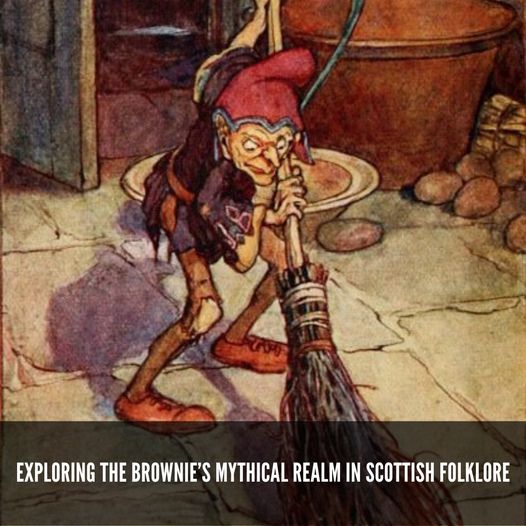In the rich tapestry of Scottish folklore, the Brownie holds a special place, enchanting people with tales of their benevolence and mysterious ways. These small, dwarf-like creatures, known for their good deeds and peculiar habits, have been a part of Scottish lore for centuries, capturing the imagination of both young and old.
Physical Description and Characteristics
Brownies are often depicted as small, dwarf-like figures with distinct features that set them apart in the world of mythical beings. They are known for their coal-black eyes, which are said to be large and expressive. With their pointed ears, significant eyes, and long fingers, Brownies have a distinctive appearance that is easily recognizable in folklore. Their attire typically consists of suits in various earthy tones, blending with the natural environment they inhabit.
Behavior and Habitat
These mythical entities are believed to be drawn to the homes of good, honest, and humble individuals. They engage in nocturnal activities, entering homes to clean, organize, and sometimes even add new items. However, Brownies have a known aversion to cats and tend to avoid houses where these pets reside. To invite a visit from a Brownie, folklore suggests leaving offerings such as milk, honey, ale, porridge, and cake. These offerings are believed to increase the chances of receiving their helpful services during the night.

Brownies are not just helpers; they are also moral guardians in their own right. They are said to despise liars, murderers, crooks, or any person engaged in immoral acts. Such individuals might find themselves at the receiving end of the Brownie’s displeasure, often expressed through pranks, theft, or general disarray in their homes. This aspect of the Brownie’s character highlights their role as not just helpers but also enforcers of moral standards in folklore.
The Brownie’s Choice of Residence
Sometimes, a Brownie grows particularly fond of a household and decides to make it their permanent residence. They prefer discreet locations like attics, cellars, or woodsheds and are strictly nocturnal, working only during nighttime hours to avoid being seen.
Brownies in Social Gatherings
Contrary to their solitary work, Brownies do engage in social interactions with their kind. They are said to occasionally meet, much like family reunions, to catch up and discuss various matters. These gatherings usually occur in remote and desolate places, such as rocky cliffs, providing a sense of community among these solitary beings.
The Ùruisg or Urisk: A Unique Variant of the Brownie
In the realm of Scottish mythology, a special variant of the Brownie known as the ùruisg or urisk stands out for its unique characteristics and behaviors. Unlike the traditional Brownie, the ùruisg is found near streams and waterfalls, not in human habitations. This variant, while still kind and sociable, does not assist with household chores, differing significantly in its interactions with humans.

The ùruisg is particularly active around the end of the harvest season, contrasting its reclusive nature during spring and summer. This change in behavior marks a time when the ùruisg becomes more open to communicating with humans. The urisk has a fondness for dairy products and often persuades milkmaids to provide it with more milk. A distinctive aspect of the urisk’s appearance is its long yellow hair and the frequent depiction of it carrying a walking staff, sometimes wearing a blue bonnet. These physical attributes, along with its preferred habitat near water bodies, set the ùruisg apart from its more domestically inclined counterpart.
Cultural Significance and Representation in Folklore
The Brownie, including its variant the ùruisg, holds a significant place in Scottish folklore, representing more than just mythical beings. They embody the values, beliefs, and moral codes of the communities that narrated their tales. The Brownie’s benevolent acts towards honest and humble individuals reflect a cultural emphasis on virtue and morality. Conversely, their punitive actions against those deemed immoral underscore a societal denouncement of dishonesty and wrongdoing.
In Scottish culture, Brownies and ùruisgs are often portrayed in stories, songs, and folklore as integral components of the community’s spiritual and mythological landscape. They serve as reminders of an invisible world that coexists with the human realm, influencing it in unseen ways. These mythical creatures have been a source of fascination and inspiration for various forms of art, literature, and cultural expression, enriching Scotland’s cultural heritage.
The Brownie in Modern Times
In contemporary times, the Brownie continues to be a figure of interest, both in Scotland and beyond. Their mythical tales have been adapted into children’s stories, novels, and other media, often with a focus on their magical and mysterious nature. The Brownie serves as a connection to the rich folklore traditions of Scotland, offering a glimpse into the imaginative and spiritual aspects of its history.

The portrayal of Brownies and ùruisgs in modern literature and media often emphasizes their mystical qualities while also adapting their stories to contemporary contexts. This ongoing interest in Brownies reflects the timeless appeal of folklore and the human fascination with the mystical and unexplained.
The Brownie, along with its variant the ùruisg, represents a captivating element of Scottish folklore, embodying the intertwining of the natural and supernatural in the cultural narrative. These mythical creatures, with their unique characteristics and moral undertones, continue to capture the imagination, serving as a bridge between the past and present. Their stories, evolving yet retaining their core elements, remain a testament to the rich folklore and cultural identity of Scotland.
